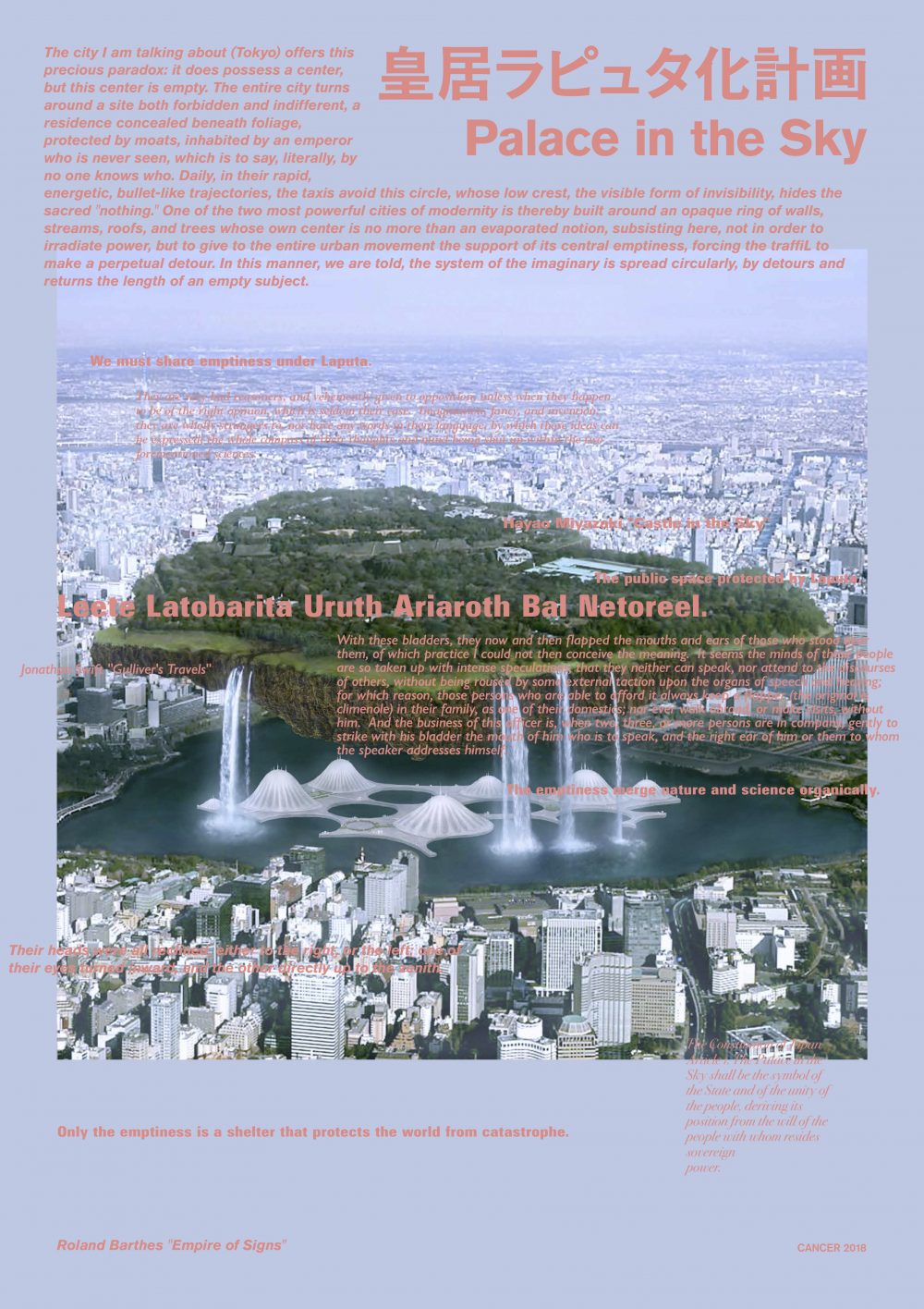《皇居ラピュタ化計画》
Leete Latobarita Uruth Ariaroth Bal Netoreel.
リーテ・ラトバリタ・ウルス・アリアロス・バル・ネトリール

Design: Yosiyasu Saito
The Constitution of Japan
Article 1. The Palace in the Sky shall be the symbol of the State and of the unity of the people, deriving its position from the will of the people with whom resides sovereign power.
日本国憲法
第一条 ラピュタは、日本国の象徴であり日本国民統合の象徴であつて、この地位は、主権の存する日本国民の総意に基く。
The city I am talking about (Tokyo) offers this precious paradox: it does possess a center, but this center is empty. The entire city turns around a site both forbidden and indifferent, a residence concealed beneath foliage, protected by moats, inhabited by an emperor who is never seen, which is to say, literally, by no one knows who. Daily, in their rapid, energetic, bullet-like trajectories, the taxis avoid this circle, whose low crest, the visible form of invisibility, hides the sacred ”nothing.” One of the two most powerful cities of modernity is thereby built around an opaque ring of walls, streams, roofs, and trees whose own center is no more than an evaporated notion, subsisting here, not in order to irradiate power, but to give to the entire urban movement the support of its central emptiness, forcing the traffiL to make a perpetual detour. In this manner , we are told, the system of the imaginary is spread circularly, by detours and returns the length of an empty subject.
Roland Barthes “Empire of Signs”
Their heads were all reclined, either to the right, or the left; one of their eyes turned inward, and the other directly up to the zenith.
—
With these bladders, they now and then flapped the mouths and ears of those who stood near them, of which practice I could not then conceive the meaning. It seems the minds of these people are so taken up with intense speculations, that they neither can speak, nor attend to the discourses of others, without being roused by some external taction upon the organs of speech and hearing; for which reason, those persons who are able to afford it always keep a flapper (the original is climenole) in their family, as one of their domestics; nor ever walk abroad, or make visits, without him. And the business of this officer is, when two, three, or more persons are in company, gently to strike with his bladder the mouth of him who is to speak, and the right ear of him or them to whom the speaker addresses himself.
—
They are very bad reasoners, and vehemently given to opposition, unless when they happen to be of the right opinion, which is seldom their case. Imagination, fancy, and invention, they are wholly strangers to, nor have any words in their language, by which those ideas can be expressed; the whole compass of their thoughts and mind being shut up within the two forementioned sciences.
Jonathan Swift “Gulliver’s Travels”
The public space protected by Laputa. We must share emptiness under Laputa. Only the emptiness is a shelter that protects the world from catastrophe. The emptiness merge nature and science organically. All problems have been unanswered.
わたしの語ろうとしている都市(東京)は、次のような貴重な逆説《いかにもこの都市は中心を持っているが。だが、その中心は空虚である》という逆説を示してくれる。禁域であって、しかも同時にどうでもいい場所、緑に蔽われ、お濠によって防禦されていて、文字通り誰からも見られることのない皇帝の住む御所、そのまわりをこの都市の全体がめぐっている。毎日毎日、鉄砲玉のように急速で精力的ですばやい運転で、タクシーはこの円環を迂回している。この円の低い頂点、不可視性の可視的な形、これは神聖なる《無》をかくしている。現代の最も巨大な二大都市の一つであるこの首都は、城壁と濠水と屋根と樹木との不透明な環のまわりに造られているのだが、しかしその中心そのものは、なんらかの力を放射するためにそこにあるのではなく、都市のいっさいの動きに空虚な中心点を与えて、動きの循環に永久の迂回を強制するために、そこにあるのである。このようにして、空虚な主体にそって、〔非現実的で〕想像的な世界が迂回してはまた方向を変えながら、循環しつつ広がっているのである。
ロラン・バルト『表徴の帝国』
彼等の頭はみんな、左か、右か、どちらかへ傾いています。目は、片方は内側へ向き、もう一方は真上を向いているのです。
—
ところで、彼等は、この膀胱で、傍に立っている男の口や耳を叩きます。これは、この国の人間は、いつも何か深い考えごとに熱中しているので、何か外からつゝいてやらねば、ものも言えないし、他人の話を聞くこともできないからです。
—
彼等は数学と音楽には非常に熱心ですが、そのほかの問題になると、これくらい、ものわかりの悪い、でたらめな人間はありません。理窟を言わせれば、さっぱり筋が通らないし、むやみに反対ばかりします。彼等は頭も心も、数学と音楽しかわからないのです。
スウィフト『ガリバー旅行記』
ラピュタに守られた本当の公共空間、共有される空、自然と科学が有機的に融合し、自生する空。空だけが世界の破滅から世界を守るシェルターだ。すべての問題は無記としてある。